
10 Weird Animals that Blend with Nature
Nature has its way of cooking up the most unexpected wonders. The flora and fauna that constitute the biodiversity around us are indeed worth appreciating. The curious nature of animal habitats, their calls, mating habits and the likes have always fascinated us. Here we have drawn up a list of ten curious animals which blend effortlessly into their backgrounds when need be. As we all know, camouflage properties can be a very effective asset for self defense. However this list has been drawn up only to satiate our intellectual curiosity (and of course a few fascinated sighs).
10. The Baron Caterpillar
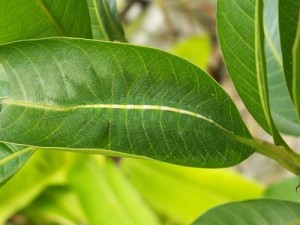
The common baron caterpillar has mastered the art of disguise, as you might say. It uses the art of camouflage as an effective means of self defense to hide from predators. Needless to say, the survival rate of common baron caterpillars receives a boost.
Native to India and South east Asia, barons often feed on the leaves of mango trees and have devised an elaborate mechanism of color and shape evolution to blend in perfectly with the mango leaves in the background. That does not make the a favorite with mango farmers though, should we mention.
9. The Pygmy Seahorse
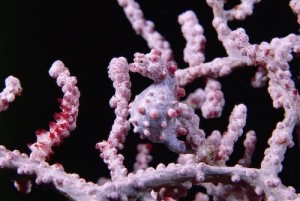
It measures less than an inch in length and is so adept in camouflaging that it was not discovered until the coral reef it inhabits was very closely examined in the laboratory. But we can not deny the prettiness of this minuscule sea creature. wow!
8. The Stick Insects
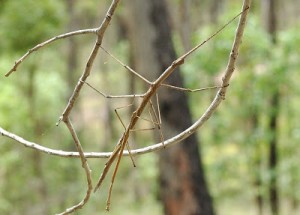
Belonging to the scientific order called Phasmatodea, these insects are variously known as stick insects (in Europe and Australia), walking sticks or stick-bugs (in the US and Canada). The word Phasmatodea is derived from the Greek word phasma, meaning an apparition or phantom, and refers to their uncanny resemblance to leaves and sticks. They be found all over the world in warmer zones, especially the tropics and subtropics.
7. Cuttlefish
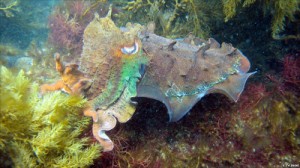
Their camouflaging capabilities have earnt them the sobriquet ‘chameleons of the sea’. They can remarkably alter and change their skin colour and pattern to communicate to other cuttlefish, to camouflage themselves and also to warn off potential predators.
What is in external appearances, right ?
6. The Decorator Crab
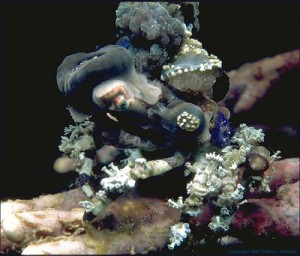
Now here is a species that uses ambient materials to decorate itself. Well they stick up plants from the surroundings and other materials on to their bodies to blend with the background and protect themselves from predators to be. Convenient.
5. The Mossy leaf-tailed gecko
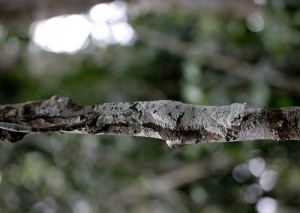
This lizard has skin that mimics the appearance of moss (you guessed it from the name, we bet). This curious species is found only in the forests of Madagascar. They live in trees and evolution has equipped their skins with “dermal flaps” that break up their outline. On top of that they can also change their skin color to go with their surroundings, not unlike chameleons.
4. The Ghost Mantis

They say there is no predator more dangerous than a master of disguise which waits patiently for its prey. This statement stands completely relevant when you come to describe the silent ghost mantis. These agile hunters will camouflage themselves against their surroundings and then wait patiently for their unfortunate victims. No wonder they re called ghosts.
3. The Eastern Screech Owl
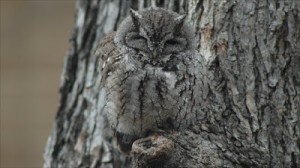
The Eastern Screech owls are majestic animals which are about 7 to 10 inches tall. They have an impressive wingspan of about 18 to 24 inches. Their plumage is dark brown or rusty grey with streaky underparts that help them blend with barks of great trees they inhabit. Mid-sized, these birds are stocky and have short tails and broad wings. Their large round heads and yellow eyes give them a rather distinct appearance.
Pale grey version of the eastern screech owl also exists in western Canada and the north-central United States.
2. The Arctic Fox

Their fur is so white that they face no problem in blending against the pristine snow of their surroundings. Scientifically known as the Alopex lagopus, the Arctic fox is also alternatively sometimes called the White Fox. They are mostly found in the Northern hemisphere, in areas of Northern Canada, Alaska and around the Arctic Circle in the tundra regions. They can also be spotted in some coastal areas.
The color of the arctic fox’s coat adapts to change in seasons. After the thawing of the ice their white coat becomes slightly thinner and a light brown coloration appears in the areas of their legs, tail and back. Some Arctic foxes re also known to have a bluish coat during the winter season which becomes darker in summer.
1. The Jaguar

It is almost fitting that the ultimate spot on this list goes to the most majestic South American cat, the Jaguar.
Scientifically known as Panthera oca, the jaguar is indeed mysterious. They can live up to a ripe old age of 16 years. Their rich yellow gold fur decorated with black spots help them blend in spotlessly with the surroundings of the South American rain forests that they inhabit.
The jaguar are majestic predators, creatures that are both incredibly dangerous and beautiful. And the ability to camouflage is just another arrow in their already overflowing quiver.
